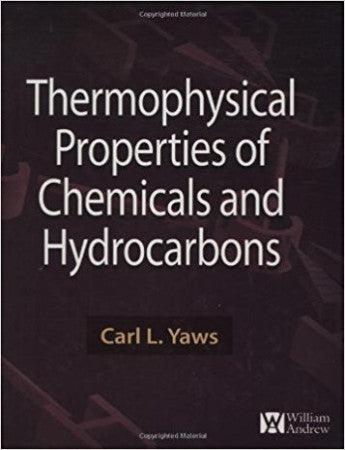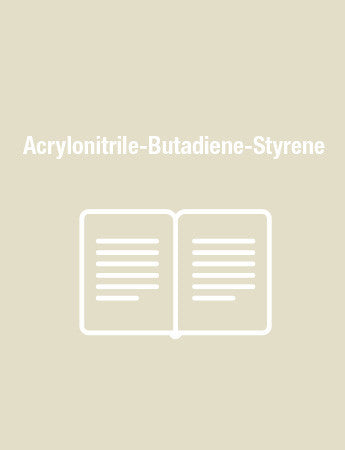Thermophysical Properties of Chemicals and Hydrocarbons
The most comprehensive collection of data on thermo-physical properties of chemicals and hydrocarbons ever compiled.
AUDIENCE
Chemical Engineers; Process Engineers; Chemists; Chemical Engineering Students; Engineers working in process design, plant operations, R&D, and industrial health and safety.
DESCRIPTION
Carl Yaws, a leading authority on chemical compounds in the chemical engineering field, has done it again. In Thermophysical Properties of Chemicals and Hydrocarbons -- an essential volume for any chemist or chemical engineer’s library -- he has amassed over 7,800 organic and inorganic chemicals, and hydrocarbons. Spanning gases, liquids, and solids, and covering all critical properties (including the acentric factor, density, enthalpy of vaporization, and surface tension), this volume represents more properties on more chemicals than any single work of its kind.
From C1 to C100 organics and Ac to Zr inorganics, the data in this handbook was designed and formatted for the field, lab or classroom usage. Organic and inorganic compounds are provided for: critical properties and acentric factor; density of liquid; density of solid; enthalpy of vaporization; enthalpy of vaporization at boiling point; enthalpy of fusion; solubility parameter and liquid volume; Van Der Waals area and volume; radius of gyration; dipole moment; and surface tension. By collecting a massive amount of information in one source, this handbook will simplify your research and significantly reduce the amount of time that you spend collecting properties data.
Chemical and process engineers, chemists, chemical engineering students, and anyone involved in process design, plant operations, R&D, industrial health and safety – and many other fields where finding properties data is important – will appreciate the unparalleled access to the invaluable data found in Thermophysical Properties of Chemicals and Hydrocarbons.
BISAC SUBJECT HEADINGS
TEC009010: TECHNOLOGY / Chemical & Biochemical
SCI013060: SCIENCE / Chemistry / Industrial & Technical
SCI013000: SCIENCE / Chemistry / General
AUDIENCE
Chemical Engineers; Process Engineers; Chemists; Chemical Engineering Students; Engineers working in process design, plant operations, R&D, and industrial health and safety.
DESCRIPTION
Carl Yaws, a leading authority on chemical compounds in the chemical engineering field, has done it again. In Thermophysical Properties of Chemicals and Hydrocarbons -- an essential volume for any chemist or chemical engineer’s library -- he has amassed over 7,800 organic and inorganic chemicals, and hydrocarbons. Spanning gases, liquids, and solids, and covering all critical properties (including the acentric factor, density, enthalpy of vaporization, and surface tension), this volume represents more properties on more chemicals than any single work of its kind.
From C1 to C100 organics and Ac to Zr inorganics, the data in this handbook was designed and formatted for the field, lab or classroom usage. Organic and inorganic compounds are provided for: critical properties and acentric factor; density of liquid; density of solid; enthalpy of vaporization; enthalpy of vaporization at boiling point; enthalpy of fusion; solubility parameter and liquid volume; Van Der Waals area and volume; radius of gyration; dipole moment; and surface tension. By collecting a massive amount of information in one source, this handbook will simplify your research and significantly reduce the amount of time that you spend collecting properties data.
Chemical and process engineers, chemists, chemical engineering students, and anyone involved in process design, plant operations, R&D, industrial health and safety – and many other fields where finding properties data is important – will appreciate the unparalleled access to the invaluable data found in Thermophysical Properties of Chemicals and Hydrocarbons.
BISAC SUBJECT HEADINGS
TEC009010: TECHNOLOGY / Chemical & Biochemical
SCI013060: SCIENCE / Chemistry / Industrial & Technical
SCI013000: SCIENCE / Chemistry / General
Properties Covered:
1. Critical Properties and Acentric Factor – Organic Compound
2. Critical Properties and Acentric Factor – Inorganic Compounds
3. Density of Liquid – Organic Compounds
4. Density of Liquid – Inorganic Compounds
5. Density of Solid – Organic Compounds
6. Density of Solid – Inorganic Compounds
7. Enthalpy of Vaporization - Organic Compounds
8. Enthalpy of Vaporization - Inorganic Compounds
9. Enthalpy of Vaporization at Boiling Point - Organic Compounds
10. Enthalpy of Vaporization at Boiling Point - Inorganic Compounds
11. Enthalpy of Fusion - Organic Compounds
12. Enthalpy of Fusion - Inorganic Compounds
13. Solubility Parameter and Liquid Volume - Organic Compounds
14. Solubility Parameter and Liquid Volume - Inorganic Compounds
15. Van Der Waals Area and Volume – Organic Compounds
16. Van Der Waals Area and Volume – Inorganic Compounds
17. Radius of Gyration – Organic Compounds
18. Radius of Gyration – Inorganic Compounds
19. Dipole Moment – Organic Compounds
20. Dipole Moment – Inorganic Compounds
21. Surface Tension - Organic Compounds
22. Surface Tension - Inorganic Compounds
1. Critical Properties and Acentric Factor – Organic Compound
2. Critical Properties and Acentric Factor – Inorganic Compounds
3. Density of Liquid – Organic Compounds
4. Density of Liquid – Inorganic Compounds
5. Density of Solid – Organic Compounds
6. Density of Solid – Inorganic Compounds
7. Enthalpy of Vaporization - Organic Compounds
8. Enthalpy of Vaporization - Inorganic Compounds
9. Enthalpy of Vaporization at Boiling Point - Organic Compounds
10. Enthalpy of Vaporization at Boiling Point - Inorganic Compounds
11. Enthalpy of Fusion - Organic Compounds
12. Enthalpy of Fusion - Inorganic Compounds
13. Solubility Parameter and Liquid Volume - Organic Compounds
14. Solubility Parameter and Liquid Volume - Inorganic Compounds
15. Van Der Waals Area and Volume – Organic Compounds
16. Van Der Waals Area and Volume – Inorganic Compounds
17. Radius of Gyration – Organic Compounds
18. Radius of Gyration – Inorganic Compounds
19. Dipole Moment – Organic Compounds
20. Dipole Moment – Inorganic Compounds
21. Surface Tension - Organic Compounds
22. Surface Tension - Inorganic Compounds
Carl L. Yaws, Ph.D. is the professor of chemical engineering at Lamar University, Beaumont, Texas. He has industrial experience in process engineering, research, development, and design at Exxon, Ethyl and Texas Instruments. He is the author of 32 books and has published more than 660 technical papers in process engineering, property data, and pollution prevention.




